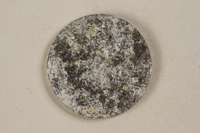Overview
- Brief Narrative
- Scrip with a receipt value of 50 cents issued in 1940 in the Jewish ghetto in Łódź, Poland, which was renamed Litzmannstadt by the Germans following their invasion and occupation of Poland in September 1939. When the Germans transferred Jews to the ghetto, they confiscated all currency in exchange for scrip that could be spent only inside the ghetto. The scrip was designed by the Judenrat [Jewish Council] of the Łódź ghetto, and includes traditional Jewish symbols.
- Date
-
issue:
1940 May 15
- Geography
-
issue:
Litzmannstadt-Getto (Łódź, Poland);
Łódź (Poland)
- Credit Line
- United States Holocaust Memorial Museum Collection, Gift of Leah Rosenfield
- Markings
- front, center, printed in black ink : QUITTUNG / ÜBER / 50 PFENNIG [Receipt for 50 Pfennig]
front, bottom, printed in black ink : DER AELTESTE DER JUDEN / IN LITZMANNSTADT / M. R[-?] / LITZMANNSTADT DEN 15 MAI 1940 [The Elder of the Jews in Lodz, (illegible signature of Mordechai Chaim Rumkowski), Lodz, the 15 of May, 1940]
back, top, printed in black ink: QUITTUNG ÜBER / FÜNFZIG PFENNIG [Receipt for 50 Pfennig]
back, lower center, printed in red ink : No 314392
back, bottom, printed black ink : WER DIESE QUITTUNG VERFÄLSCHT / ODER NACHMACHT ODER GEFÄLSCHTE / QUITTUNGEN IN VERKEHR BRINGT, / WIRD STRENGSTENS BESTRAFT [Anyone who falsifies or copies this receipt, or traffics in counterfeit receipts, will be strictly punished
Physical Details
- Language
- German
- Classification
-
Exchange Media
- Category
-
Money
- Object Type
-
Scrip (aat)
- Physical Description
- Rectangular paper scrip. Front has design of a 7-branched candelabrum, or menorah, at center, numerical denomination 50 in black ink lower left and upper right corners, and 6-pointed stars, or Magen David, in upper left and lower right corners; background is light purple, with a lattice design of 6-pointed stars. German text in black across and below menorah. Back has same light-purple background design. German text in black at top and bottom; numerical denomination 50 in black ink upper corners; serial number in lower center.
- Dimensions
- overall: Height: 2.120 inches (5.385 cm) | Width: 3.370 inches (8.56 cm)
- Materials
- overall : paper, ink
Rights & Restrictions
- Conditions on Access
- No restrictions on access
- Conditions on Use
- No restrictions on use
Keywords & Subjects
Administrative Notes
- Legal Status
- Permanent Collection
- Provenance
- The scrip was donated to the United States Holocaust Memorial Museum by Leah Rosenfield in 1994.
- Record last modified:
- 2022-07-28 18:22:28
- This page:
- https://collections.ushmm.org/search/catalog/irn8847
Download & Licensing
In-Person Research
- By Appointment
- Request 21 Days in Advance of Visit
- Plan a Research Visit
- Request to See This Object
Contact Us
Also in Leah Rosenfield collection
The collection conisists of scrip from the Łódź ghetto.
Date: 1940-1943

Łódź (Litzmannstadt) ghetto scrip, 5 mark note
Object
5 (funf) mark receipt issued in the Łódź ghetto in Poland in May 1940. Nazi Germany occupied Poland on September 1, 1939; Łódź was renamed Litzmannstadt and annexed to the German Reich. In February, the Germans forcibly relocated the large Jewish population into a sealed ghetto. All currency was confiscated in exchange for Quittungen [receipts] that could be exchanged only in the ghetto. The scrip was designed by the Judenrat [Jewish Council] and includes traditional Jewish symbols. The Germans closed the ghetto in the summer of 1944 by deporting the residents to concentration camps or killing centers.

Łódź (Litzmannstadt) ghetto scrip, 5 mark coin
Object
5 mark coin issued in the Łódź ghetto in Poland in 1943. Nazi Germany occupied Poland on September 1, 1940; Łódź was renamed Litzmannstadt and annexed to the German Reich. In February, the Germans forcibly relocated the large Jewish population into a sealed ghetto. All currency was confiscated in exchange for Quittungen [receipts] that could be exchanged only in the ghetto. The scrip and tokens were designed by the Judenrat [Jewish Council] and includes traditional Jewish symbols. The Germans closed the ghetto in the summer of 1944 by deporting the residents to concentration camps or killing centers.



